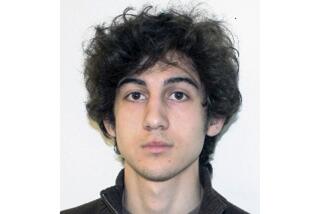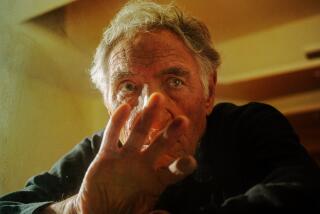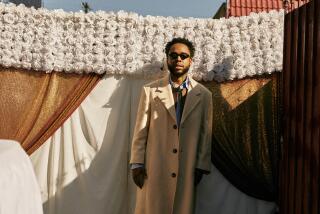Trayvon Martin and Dzhokhar Tsarnaev: A tale of two photos
- Share via
Two self-generated photos by two young men. One “looks” guilty. One “looks” innocent.
The power of images to shape or confuse our understanding of events has never been more apparent than in two hugely emotional cases that have generated enormous coverage and national soul searching: the Trayvon Martin killing, and the Boston Marathon bombings.
In that now-famous photo of Trayvon Martin, a teenager stares at the camera. He is nearly expressionless. A gray hoodie frames his face. To many Americans invested in George Zimmerman’s innocence, this was proof of Martin’s menacing intentions.
What about that photo of the younger Martin in his red Hollister T-shirt, the one that was widely circulated just after Zimmerman killed him? That, they said, was proof that the media had it out for Zimmerman.
In a hoodie, here was Martin’s real self: Dark, dangerous and up to no good. “A real suspicious guy,” as Zimmerman said.
Except he wasn’t. He was an imperfect teenager on his way home from a corner store in the rain. In the aftermath of Martin’s fatal encounter with the neighborhood watchman, the hoodie has become a symbol of all the knee-jerk fears and suspicions piled on African American teenage boys.
Even President Obama was moved to address the freight of that history. On Friday, in a shining and necessary unscripted moment, he offered much needed context for the pain that Zimmerman’s exoneration has caused for so many black Americans:
“There are very few African American men in this country who haven’t had the experience of being followed when they were shopping in a department store. That includes me. There are very few African American men who haven’t had the experience of walking across the street and hearing the locks click on the doors of cars. That happens to me -- at least before I was a senator. There are very few African Americans who haven’t had the experience of getting on an elevator and a woman clutching her purse nervously and holding her breath until she had a chance to get off. That happens often.
“And I don’t want to exaggerate this, but those sets of experiences inform how the African American community interprets what happened one night in Florida. And it’s inescapable for people to bring those experiences to bear. The African American community is also knowledgeable that there is a history of racial disparities in the application of our criminal laws -- everything from the death penalty to enforcement of our drug laws. And that ends up having an impact in terms of how people interpret the case.
”... The fact that a lot of African American boys are painted with a broad brush and the excuse is given, well, there are these statistics out there that show that African American boys are more violent -- using that as an excuse to then see sons treated differently causes pain.
“I think the African American community is also not naïve in understanding that, statistically, somebody like Trayvon Martin was statistically more likely to be shot by a peer than he was by somebody else. So folks understand the challenges that exist for African American boys. But they get frustrated, I think, if they feel that there’s no context for it and that context is being denied. And that all contributes I think to a sense that if a white male teen was involved in the same kind of scenario, that, from top to bottom, both the outcome and the aftermath might have been different.”
In the same week, the president stepped forward to address what has become a polarizing national issue: Rolling Stone magazine created an uproar when it put accused Boston Bomber Dzhokhar Tsarnaev on its cover.
In that photo, Tsarnaev’s large brown eyes and penumbra of curly dark hair evoked the famous Rolling Stone photos of Jim Morrison in his beautiful boy heyday.
To many critics, it was a slap in the face to all the victims of the April bombing. Tsarnaev looked young, angelic and anything but guilty. By extension, they argued, Rolling Stone was pushing a narrative. But that simplistic take is wrong; it falls apart at the cover lines, which call Tsarnaev a “monster.”
Still, Boston’s mayor reacted angrily, retailers removed the magazine from their shelves, and a “furious” Massachusetts state police photographer, Sean Murphy, has apparently jeopardized his job by releasing several gritty shots of the suspect the night of his arrest.
Published by Boston Magazine, those photos show Tsarnaev climbing out of the boat where he’d hid, bloody and disoriented, with a laser light on his forehead.
“Murphy,” said the magazine, “wants the world to know that the Tsarnaev in the photos he took that night -- defeated and barely alive, with the red dots of sniper rifles lighting up his forehead -- is the real face of terrorism, not the handsome, confident young man shown on the magazine cover.”
The power of the Rolling Stone cover lies, of course, in its shock value. One can’t help but wonder: How does a sweet-looking kid like that turn into a terrorist? The very question legitimizes Rolling Stone’s choice, as inside the magazine, the well-reported story probes the puzzling transformation of Tsarnaev from coddled Cambridge stoner and assimilated immigrant to apparent America-hating Islamist.
Did the photo of Martin in his hoodie pack a similar shock? Not to my eyes. I’ve yet to see a photo of Martin -- and many fake ones have circulated -- that makes me think he deserved to be followed home by car, then on foot, by a suspicious neighbor.
So what do we learn about Trayvon Martin and Dzhokhar Tsarnaev from their iconic photos?
Not much, as it happens.
What they truly reveal is what is in our own hearts and minds.
ALSO:
Idyllwild open and back in business after fire threat
Flash flood watch issued for parts of L.A., Ventura counties
More to Read
Sign up for Essential California
The most important California stories and recommendations in your inbox every morning.
You may occasionally receive promotional content from the Los Angeles Times.











